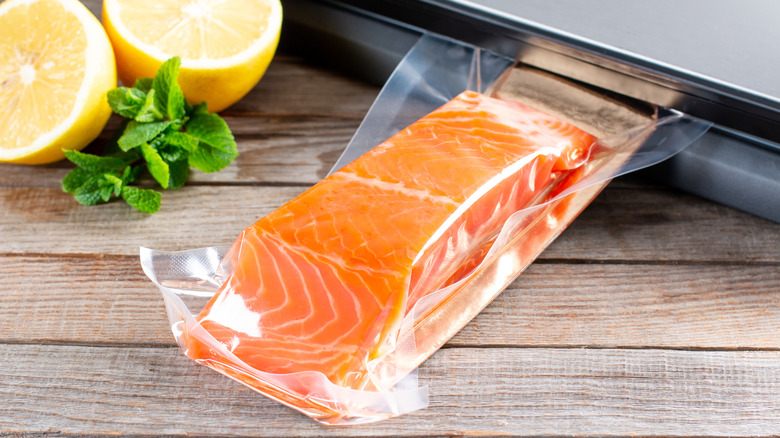The Step You Can't Skip Before Freezing Fish
If you've struggled to preserve your fish's texture and flavor in the freezer, fear no more. For the best results, vacuum-seal your fish to totally prevent it from getting freezer burn. If you can't, then wrap your fish in plastic or seal it in a zip-lock bag, and make sure that your freezer is as cold as possible.
If you're freezing fish whole, rinse it under cold running water and pat it dry. Remove any parts you don't want — though keep the skin on as this will help retain the fish's natural moisture. From there, double-wrap your fish in plastic. The thicker the plastic, the better, as you want to keep the fish as well insulated as possible to avoid freezer burn. This is where double wrapping helps, too. Make sure that there are absolutely no openings in the casing as air exposure will degrade the texture and quality of the fish (however, it will still be safe to eat).
Another method is to place the fish in a zip-lock bag and remove as much air as possible. You can also fill the bag with water for extra insulation, but be warned that some people find this makes the fish too watery when cooked. It's sometimes recommended to ice-glaze fish before freezing, which means dipping the fish in cold salt water and freezing it (unwrapped) for a few minutes before sealing and freezing again. This step is helpful to stop air exposure — though ultimately not necessary.
How to thaw your frozen fish
Slow and steady is the way to approach defrosting fish. If the temperature changes too quickly, thinner parts of the fish will thaw way ahead of others, inviting bacteria to spoil the whole thing. The thawing method is the same regardless of how you sealed the fish. Place the frozen fish in the refrigerator, and wait until it feels spongy and springy again. As it defrosts, excess water may accumulate in the packaging, which you can remove if you want, but it shouldn't be enough to damage the texture of the fish.
The hardest part about thawing frozen fish is the amount of time it takes. You're looking at a good few hours, even up to a full day for larger pieces or whole fish. If you're in a pinch and need it defrosted sooner, the best option is to set it in a bowl of cool water. Ensure the whole fish is submerged for balanced thawing, and it should be ready to go in under two hours if you change the water frequently. Once fully thawed, your fish will be ready to transform into crispy beer-battered filets, gourmet grilled sea bass with garlic butter, or a simple Dijon-crusted salmon.


